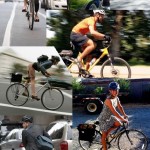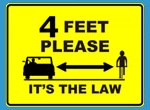Tips from our October 11, 2010 Meeting
Maneuvering Tips
Slow & Steady
When there’s even the chance of ice on the road, slow down. If you do encounter an ice patch, DON’T PANIC — keep your line, keep your hands off the brakes, and ride through it. If you try to turn or stop on an icy section of roadway, you’re most likely going to fall. Be especially careful at dusk and dawn when the road surfaces are just freezing or still frozen.
Generally, though, the SLOW DOWN tip is applicable to all bad weather conditions, just as it is in other vehicles.
Winter Conditions
In the area, even after a large snowstorm, roads are usually clear enough for riding within 1-3 days of a storm.
State College Borough, Ferguson Township, Penn State plow their bike lanes and paths after street snow removal is done. College Township plows some paths, but not all. Patton and Harris do not currently provide winter maintenance for their bike paths. (Bicyclists in those townships who’d like to see winter clearing are encouraged to attend a supervisor’s meeting and make a comment during the public comment portion!)
Update 2019: While we reported earlier that Harris and College Twps were clearing the South Atherton bikeway, in 2018-19, that isn’t being done. Use those paths in winter? Call the townships and let them know. Winter 2016: Harris Township is now clearing the S. Atherton Bikeway. Thanks to Centre Bike’s Jim Serene, Township Manager Amy Farkas and the Harris Twp Board of Supervisors for making this happen.
Clothing
Dry 50-60 Degree
- Torso – Short sleeve jersey, arm warmers
- Legs – Shorts with knee warmers, Knickers, Capris
- Hands – Short finger gloves, light full-finger gloves
- Feet – mid cuff socks, shoes
- Head – headband for ears under helmet
Dry 30-49 Degree
- Torso – Long sleeve jersey, long sleeve base layer, vest
- Legs – Knickers/Capris with leg warmers, light/midweight tights
- Hands – Full-finger gloves
- Feet – Wool socks, shoes
- Head – Helmet cover/liner or skull cap under helmet
Dry 10-29 Degree
- Torso –Long sleeve jersey, long sleeve baselayer, wind breaking thermal jacket
- Legs – Insulated tights over shorts or Capris, Wind pants over knickers & warmers
- Hands – Cold weather full-finger gloves, Lobster gloves, handwarmers, glove liners
- Feet – Thick wool socks, shoes, thermal shoe covers, or winter riding boots
- Head – Balaclava under helmet, helmet cover
Dry 0 Degree
- Torso –Long sleeve thermal jersey, long sleeve baselayer, insulated wind jacket
- Legs – Insulated tights with baggy overlayer
- Hands – Cold weather full-finger gloves, Lobster Gloves, Handwarmers, glove liners
- Feet – Thick wool socks, shoes, thermal shoe covers, or winter riding boots
- Head – Balaclava under helmet, eye protection
Rainy Conditions
Rain protection is either waterproof or water resistant. Waterproof means that seams will be sealed and breathability will diminish. Ventilation is important. Water resistant means that water could get through in a downpour, but a shower will be kept out. Water resistant is much more breathable and does not need added ventilation. Armpit ventilation is a nice extra to have if you are buying new rain gear (or any jacket for that matter).
Equipment
Tires
For snowy and icy conditions, reduce tire pressure for better traction. Try 40-50% of the rated pressure to start, but you’ll have to experiment based on your weight and the tire size. Too low a pressure and the tire will want to come off the rim. Mountain Bike or Cyclocross knobby tires are recommended for winter conditions (but under dry conditions, standard tires are fine, too). Studded tires are available, but the consensus was that studs are good where there are continual icy conditions, such as trail riding, but that they don’t work as well on wet or dry pavement. The attendees preferred regular tires to studded tires for mixed pavement/snow/ice riding.
Lights
In the winter, when daylight is at a premium and conditions can change quickly, don’t go out without them. Front and back. Minimally, use blinking lights that can be seen 500 ft in either direction. Better, are higher power headlamps because they not only allow you to be seen, but let you see road obstacles such as downed limbs, potholes, or piles of ice/snow. With the proliferation of smart phones and distracted drivers, we now suggest front and rear lights 24/7/365, especially with strobe/blinking modes. You need to get those drivers eyes looking up.
Helmet
Two words: Wear one! Always. This is under Equipment and not Clothing because we don’t feel a helmet is optional, especially in winter conditions. You buckle up each time you get into your car, right? Then put a helmet on each time you get on your bike. A fall in winter conditions is more likely than in other seasons and rather than being surrounded by two tons of steel and protected by a seat belt and air bags, your head is at risk for collisions with those two ton missiles and believe us, it’s more fragile than you like to think.
Derailleurs and chains
Keep your chain and derailleur pivot points clean and well-lubricated. This is especially important in Central PA where road salt is heavily used.
Brakes
A quick wipe of your rims and brake pads after a ride will keep accumulated grit from damaging wheel braking surfaces. Lube the brake pivot points as you do your derailleurs.
Something we forgot? Add a comment below and share your tips with us.



